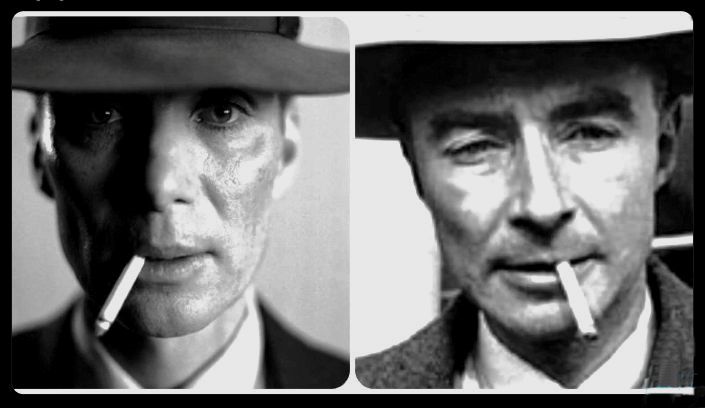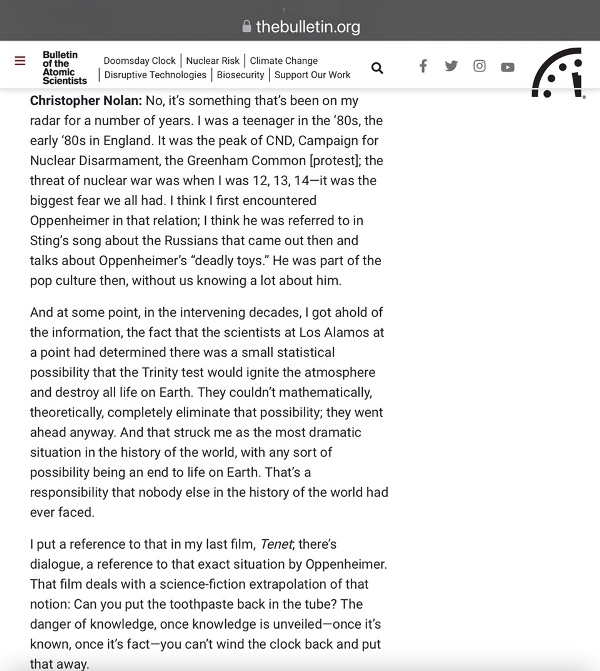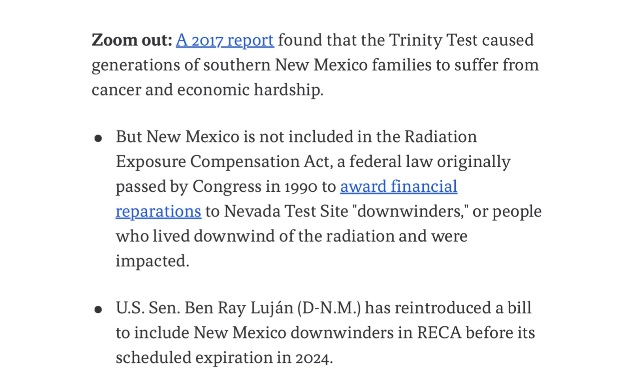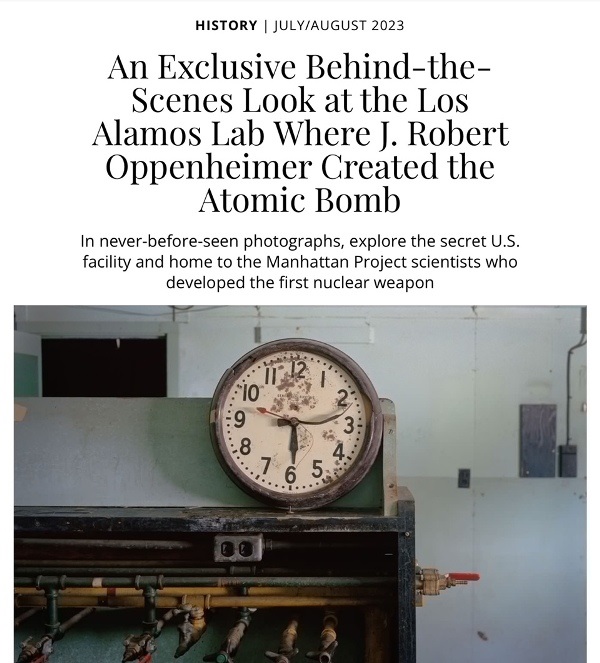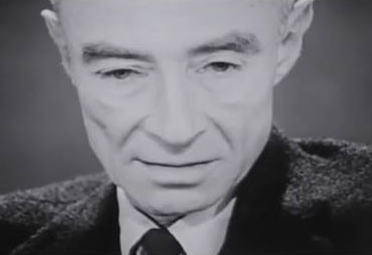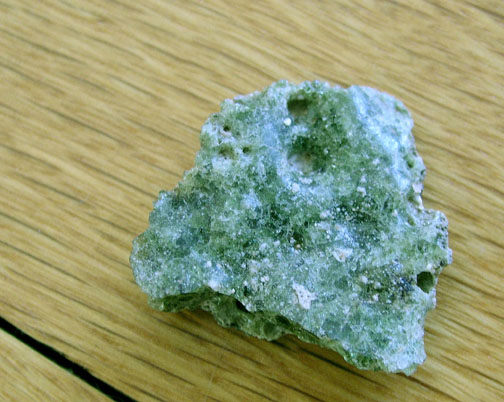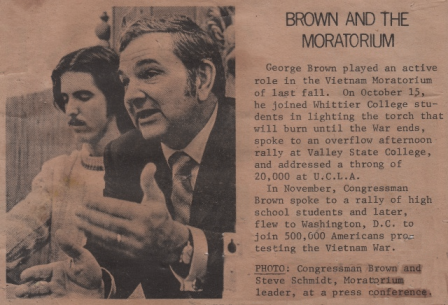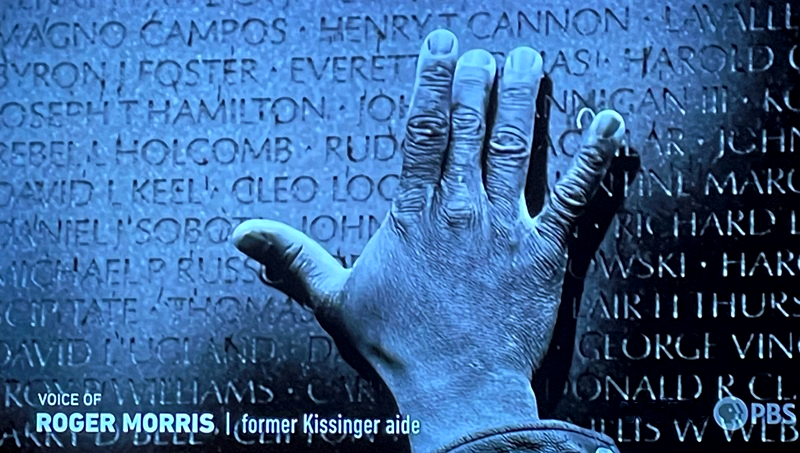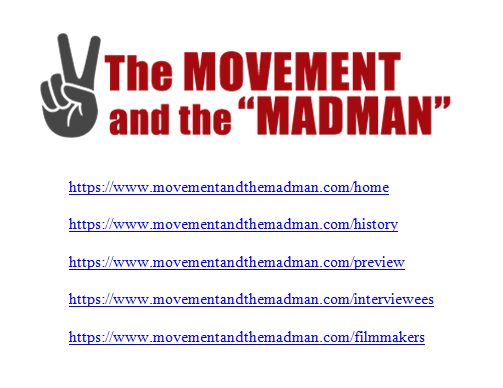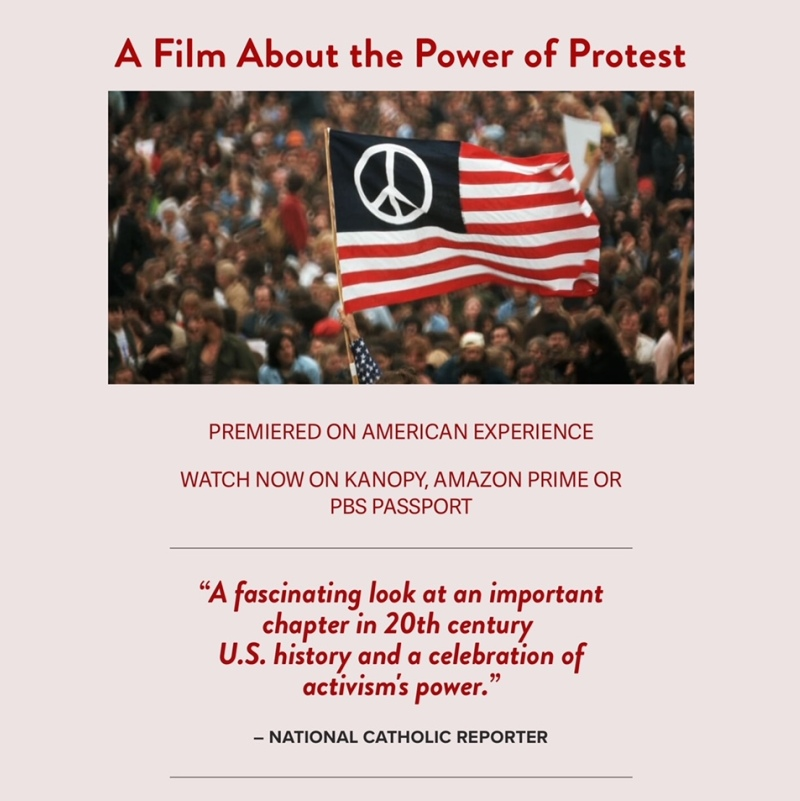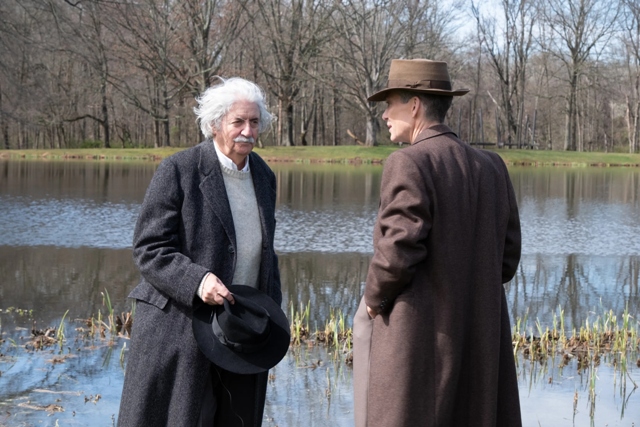File:Oppenheimer movie - 2023.jpg: Difference between revisions
Siterunner (talk | contribs) No edit summary |
Siterunner (talk | contribs) No edit summary |
||
| (18 intermediate revisions by the same user not shown) | |||
| Line 28: | Line 28: | ||
'''Via Variety''' ('the industry' news of record) | '''Via Variety''' ('the industry' news of record) | ||
''Christopher Nolan Says Some ‘Oppenheimer’ Viewers Walk Out ‘Devastated’ and ‘They Can’t Speak’: ‘It’s Kind of a Horror Movie’'' | ''Christopher Nolan Says Some ‘Oppenheimer’ Viewers Walk Out ‘Devastated’ and ‘They Can’t Speak’: ‘It’s Kind of a Horror Movie’'' | ||
| Line 47: | Line 47: | ||
* https://www.newyorker.com/culture/culture-desk/oppenheimer-nullified-and-vindicated | * https://www.newyorker.com/culture/culture-desk/oppenheimer-nullified-and-vindicated | ||
Look back to John Hersey's 1946 first-hand account from Hiroshima in the aftermath of the atomic blast... | |||
<big>'''Hiroshima'''</big> | |||
* https://www.newyorker.com/magazine/1946/08/31/hiroshima | |||
* https://oppenheimer2023.substack.com/p/77-years-ago-john-hersey-exposed | |||
* https://en.wikipedia.org/wiki/Hiroshima_(book) | |||
Hersey’s 31,000-words recall the August 6th bombing through the stories of six survivors. | |||
''At exactly fifteen minutes past eight in the morning, on August 6, 1945, Japanese time, at the moment when the atomic bomb flashed above Hiroshima, Miss Toshiko Sasaki, a clerk in the personnel department of the East Asia Tin Works, had just sat down at her place in the plant office and was turning her head to speak to the girl at the next desk. At that same moment, Dr. Masakazu Fujii was settling down cross-legged to read the Osaka Asahi on the porch of his private hospital, overhanging one of the seven deltaic rivers which divide Hiroshima; Mrs. Hatsuyo Nakamura, a tailor’s widow, stood by the window of her kitchen, watching a neighbor tearing down his house because it lay in the path of an air-raid-defense fire lane; Father Wilhelm Kleinsorge, a German priest of the Society of Jesus, reclined in his underwear on a cot on the top floor of his order’s three-story mission house, reading a Jesuit magazine,Stimmen der Zeit; Dr. Terufumi Sasaki, a young member of the surgical staff of the city’s large, modern Red Cross Hospital, walked along one of the hospital corridors with a blood specimen for a Wassermann test in his hand; and the Reverend Mr. Kiyoshi Tanimoto, pastor of the Hiroshima Methodist Church, paused at the door of a rich man’s house in Koi, the city’s western suburb, and prepared to unload a handcart full of things he had evacuated from town in fear of the massive B-29 raid which everyone expected Hiroshima to suffer. A hundred thousand people were killed by the atomic bomb, and these six were among the survivors. They still wonder why they lived when so many others died. Each of them counts many small items of chance or volition—a step taken in time, a decision to go indoors, catching one streetcar instead of the next—that spared him. And now each knows that in the act of survival he lived a dozen lives and saw more death than he ever thought he would see. At the time, none of them knew anything.'' | |||
“I believe Mr. Hersey has given a true picture of the appalling effect on human beings. . . . And this picture has implications for the future of mankind which must deeply concern all responsible men and women.” | |||
-- Albert Einstein | |||
| Line 52: | Line 71: | ||
''' | '''Via NPR''' | ||
* https://www. | '''The Story Of The Journalist Who Exposed The 'Hiroshima Cover-Up' ''' | ||
* https://www.npr.org/2020/08/19/903826363/fallout-tells-the-story-of-the-journalist-who-exposed-the-hiroshima-cover-up | |||
| Line 284: | Line 305: | ||
* https://en.wikipedia.org/wiki/American_Prometheus | * https://en.wikipedia.org/wiki/American_Prometheus | ||
| Line 291: | Line 313: | ||
<big>'''[[Nuclear Weapons]]</big> | |||
<big><big><big>'''[[Nuclear Weapons]]</big></big></big> | |||
Via GreenPolicy360 | Via GreenPolicy360 | ||
| Line 311: | Line 334: | ||
[[File:Trinitite .jpg]] | :[[File:Trinitite .jpg]] | ||
| Line 322: | Line 346: | ||
''As I look back at the Nuclear Era, and writing about nuclear risks since my teen-age years and debating nuclear proliferation in high school debates in California. Congressman [https://www.greenpolicy360.net/w/George_E._Brown_Jr George Brown] was a source of much information as we began a three-decade long working relationship that spanned from nuclear and Vietnam war risks to big science and the beginnings of the [https://www.greenpolicy360.net/w/Environmental_movement environmental movement]. Later, the beginning of an international Green party in Germany began serious political work at forefront of the Cold War nuclear chasm, and my work grew to include peacetime campaign platform work with [https://www.greenpolicy360.net/w/Governor_Jerry_Brown Gov. Jerry Brown], who is | [[File:Rep George Brown and Steve Schmidt - Oct 15, 1969 - 448x305.png]] | ||
<small>Steve Schmidt, Vietnam Moratorium Coordinator, and Representative George E. Brown (D - Los Angeles)</small> | |||
<big><big>'''The Near Use of Nuclear Weapons during the Vietnam War'''</big></big> | |||
:PBS Documentary in 2023 reveals that the Vietnam Moratorium/Peace Movement stopped President Nixon from 'dropping the Bomb' | |||
[[File:PBS Documentary - Movement and the Madman 6.png]] | |||
<big><big>'''The Movement and the 'Madman' '''</big></big> | |||
'''PBS, PREMIERED MARCH 28, 2023 ON AMERICAN EXPERIENCE''' | |||
The documentary film tells the little-known story of a dramatic showdown between a protest movement and a president | |||
: The Vietnam Moratorium mobilization of October-November 1969 revealed to have stopped Nixon from using nuclear weapons | |||
:* https://www.movementandthemadman.com/home | |||
:* https://www.movementandthemadman.com/history | |||
:* https://www.movementandthemadman.com/preview | |||
:* https://www.movementandthemadman.com/interviewees | |||
:* https://www.movementandthemadman.com/filmmakers | |||
[[File:The Movement and the Madman - PBS - March 2023.png]] | |||
| |||
[[File:A Film About the Power of Protest.png]] | |||
<big>SJS / Siterunner:</big> | |||
''As I look back at the Nuclear Era, and writing about nuclear risks since my teen-age years and debating nuclear proliferation in high school debates in California. Congressman [https://www.greenpolicy360.net/w/George_E._Brown_Jr George Brown] was a source of much information as we began a three-decade long working relationship that spanned from nuclear and Vietnam war risks to big science and the beginnings of the [https://www.greenpolicy360.net/w/Environmental_movement environmental movement]. Later, the beginning of an international Green party in Germany began serious political work at forefront of the Cold War nuclear chasm, and my work grew to include peacetime campaign platform work with [https://www.greenpolicy360.net/w/Governor_Jerry_Brown Gov. Jerry Brown], who is now on the board of [http://www.nti.org/ the Nuclear Threat Initiative / NTI]. Later, I went on to the drafting of the founding [https://www.greenpolicy360.net/w/Category:Green_Platform US Green Party platform], with anti-nuclear weapons peace planks, and establishing [http://www.strategicdemands StrategicDemands.com] / [https://www.strategicdemands.com/strategic-vision/ A New Strategic Vision].'' | |||
| Line 332: | Line 395: | ||
<big>'''GreenPolicy360 Siterunner, Steven J. Schmidt'''</big> | <big>'''GreenPolicy360 Siterunner, Steven J. Schmidt'''</big> | ||
: <big>'''Recalling My Father's Nuclear Flyover and Training Mission''''</big> | : <big>'''Recalling My Father's Nuclear Flyover and 'Training Mission''''</big> | ||
| Line 382: | Line 445: | ||
Seth Shelden (United Nations Liaison for the International Campaign to Abolish Nuclear Weapons): The average bomb in one of the U.S. arsenals, let’s say, is somewhere between five times and 30 times bigger than what was used in the Trinity test, which was the same size as the Hiroshima bomb. We have some in our arsenal that are over a megaton, so 80 times bigger than what we dropped in Hiroshima. The largest weapon that’s ever been tested, I think it’s over 3,000 Hiroshima bombs. That’s the Tsar Bomb. It shattered windows in other countries when it was tested. | Seth Shelden (United Nations Liaison for the International Campaign to Abolish Nuclear Weapons): The average bomb in one of the U.S. arsenals, let’s say, is somewhere between five times and 30 times bigger than what was used in the Trinity test, which was the same size as the Hiroshima bomb. We have some in our arsenal that are over a megaton, so 80 times bigger than what we dropped in Hiroshima. The largest weapon that’s ever been tested, I think it’s over 3,000 Hiroshima bombs. That’s the Tsar Bomb. It shattered windows in other countries when it was tested. | ||
The basic answer is that the weapons that were used in New | The basic answer is that the weapons that were used in New Mexico — and in Hiroshima and Nagasaki, which killed hundreds of thousands of people — look like colonial muskets by comparison to what we have now. | ||
♦ | |||
Alongside a pond in Princeton... | |||
[[File:Scene-oppenheimer-albert-einstein-1001343664.jpg]] | |||
[[File:Ripple in the water.jpg|link=https://greenpolicy360.net/w/File:Scene-oppenheimer-albert-einstein-1001343664.jpg]] | |||
''“When I came to you with those calculations,” Oppenheimer tells Einstein... | |||
“we thought we might start a chain reaction that might destroy the entire world.”'' | |||
''“What of it?” Einstein asks.'' | ''“What of it?” Einstein asks.'' | ||
''Oppenheimer: ''“I believe we did.” '' | ''Oppenheimer: ''“I believe we did.” '' | ||
'''The movie's last line is of raindrops in the water''' | |||
:: '''No longer theory, our physics are ripples set in motion''' | |||
::: '''Have we destroyed the world...''' | |||
:::: [https://www.vulture.com/article/oppenheimer-ending-explained-christopher-nolan.html '''"I believe we did..."'''] | |||
| Line 411: | Line 486: | ||
[[File:Trinity monument m.jpg]] | [[File:Trinity monument m.jpg]] | ||
Latest revision as of 12:55, 15 March 2024
Oppenheimer
- The Movie / July 2023
Spotlight on the man, J. Robert Oppenheimer...
♦
Reviews of Oppenheimer, the movie ... and GreenPolicy360 & Strategic Demands thoughts on nuclear risks, nuclear proliferation, and generational legacy of nuclear 'atomic fire'...
♦
Via Variety ('the industry' news of record)
Christopher Nolan Says Some ‘Oppenheimer’ Viewers Walk Out ‘Devastated’ and ‘They Can’t Speak’: ‘It’s Kind of a Horror Movie’
One outspoken fan of “Oppenheimer” ahead of the film’s July theatrical release is historian Kai Bird, who co-wrote the 2005 biography “American Prometheus: The Triumph and Tragedy of J. Robert Oppenheimer” with Martin J. Sherwin. Nolan adapted the book into “Oppenheimer.”
“I am, at the moment, stunned and emotionally recovering from having seen it,” Bird said during a recent conversation. “I think it is going to be a stunning artistic achievement, and I have hopes it will actually stimulate a national, even global conversation about the issues that Oppenheimer was desperate to speak out about — about how to live in the atomic age, how to live with the bomb and about McCarthyism — what it means to be a patriot, and what is the role for a scientist in a society drenched with technology and science, to speak out about public issues.”
♦
Via the New Yorker
In 1954, America’s most celebrated scientist was falsely accused and publicly humiliated, sending a warning to all scientists not to engage in the political arena as public intellectuals. This was the real tragedy of the Oppenheimer case. What happened to him damaged our ability as a society to debate honestly about scientific theory—the very foundation of our modern world. Granholm’s courageous decision has reaffirmed not only that the federal government is capable of correcting its mistakes but that government employees, regardless of their stature, can express opinions that challenge the conventional wisdom without fear that they will be falsely branded as disloyal.
Look back to John Hersey's 1946 first-hand account from Hiroshima in the aftermath of the atomic blast...
Hiroshima
- https://www.newyorker.com/magazine/1946/08/31/hiroshima
- https://oppenheimer2023.substack.com/p/77-years-ago-john-hersey-exposed
- https://en.wikipedia.org/wiki/Hiroshima_(book)
Hersey’s 31,000-words recall the August 6th bombing through the stories of six survivors.
At exactly fifteen minutes past eight in the morning, on August 6, 1945, Japanese time, at the moment when the atomic bomb flashed above Hiroshima, Miss Toshiko Sasaki, a clerk in the personnel department of the East Asia Tin Works, had just sat down at her place in the plant office and was turning her head to speak to the girl at the next desk. At that same moment, Dr. Masakazu Fujii was settling down cross-legged to read the Osaka Asahi on the porch of his private hospital, overhanging one of the seven deltaic rivers which divide Hiroshima; Mrs. Hatsuyo Nakamura, a tailor’s widow, stood by the window of her kitchen, watching a neighbor tearing down his house because it lay in the path of an air-raid-defense fire lane; Father Wilhelm Kleinsorge, a German priest of the Society of Jesus, reclined in his underwear on a cot on the top floor of his order’s three-story mission house, reading a Jesuit magazine,Stimmen der Zeit; Dr. Terufumi Sasaki, a young member of the surgical staff of the city’s large, modern Red Cross Hospital, walked along one of the hospital corridors with a blood specimen for a Wassermann test in his hand; and the Reverend Mr. Kiyoshi Tanimoto, pastor of the Hiroshima Methodist Church, paused at the door of a rich man’s house in Koi, the city’s western suburb, and prepared to unload a handcart full of things he had evacuated from town in fear of the massive B-29 raid which everyone expected Hiroshima to suffer. A hundred thousand people were killed by the atomic bomb, and these six were among the survivors. They still wonder why they lived when so many others died. Each of them counts many small items of chance or volition—a step taken in time, a decision to go indoors, catching one streetcar instead of the next—that spared him. And now each knows that in the act of survival he lived a dozen lives and saw more death than he ever thought he would see. At the time, none of them knew anything.
“I believe Mr. Hersey has given a true picture of the appalling effect on human beings. . . . And this picture has implications for the future of mankind which must deeply concern all responsible men and women.”
-- Albert Einstein
♦
Via NPR
The Story Of The Journalist Who Exposed The 'Hiroshima Cover-Up'
♦
Via CNN
At the height of the Cold War, when mutually assured destruction was at its crazed height, nuclear warfare found itself abstracted through humor – perhaps the only reasonable way to treat something so fearsome. The bomb was a sick joke to be ridden, sometimes metaphorically, sometimes literally, a totem of mankind’s ingenuity and stupidity riveted shut and let fly. To look at it head-on was to be blinded by its glare; the power it wrought was too absurd — and too close — to countenance. Best to send in the clowns.
It would have seemed inconceivable then, but the atomic bomb did fade out of mind. In the 21st Century, other existential threats have reared their heads. Yet the nuclear threat feels closer today than it has for generations. And it’s precisely at this moment that Christopher Nolan is asking audiences to look it soberly in the eye.
“Our relationship with nuclear weapons is very complicated,” Nolan told CNN. “The fear ebbs and flows. It’s almost like humanity can only deal with one apocalypse at a time, and there’s so many issues to worry about.”
♦
Via the Associated Press
In 1954, a probing inquiry into Oppenheimer’s leftist politics by a McCarthy-era Atomic Energy Commission stripped him of his security clearance. This provides the frame of “Oppenheimer,” along with a Senate confirmation hearing for Lewis Strauss (Robert Downey Jr.), who chaired the Atomic Energy Commission and was a stealthy nemesis to Oppenheimer.
The grubby, political machinations of these hearings — the Strauss section is captured in black and white — act like a stark X-ray of Oppenheimer’s life. It’s an often brutal, unfair interrogation that weighs Oppenheimer’s decisions and accomplishment, inevitably, in moral terms. “Who’d want to justify their whole life?” someone wonders. For the maker of the world’s most lethal weapon, it’s an especially complicated question. These separate timelines give “Oppenheimer” — dimly lit and shadowy even in the desert — a noirish quality (Nolan has said all his films are ultimately noirs) in reckoning with a physicist who spent the first half of his life in headlong pursuit of a new science and the second half wrestling with the consequences of his colossal, world-altering invention.
♦
Via the New York Times
The movie, adapted from the Pulitzer Prize-winning biography “American Prometheus” by Kai Bird and Martin J. Sherwin, is the most recent in a stream of books, features and documentaries that have chronicled the tragic birth of atomic weapons, including another Pulitzer Prize winner, “The Making of the Atomic Bomb,” by Richard Rhodes; a seven-part BBC series, “Oppenheimer”; “Fat Man and Little Boy,” starring Paul Newman as Groves; another documentary, “The Trials of J. Robert Oppenheimer”; and even a John Adams opera, “Doctor Atomic.”
♦
Behind ‘Oppenheimer,’ a Prizewinning Biography 25 Years in the Making
Author Martin Sherwin struck the deal and dived into the research. But it was only when Kai Bird joined as a collaborator that “American Prometheus” came to be. (Unlocked article about Prometheus)
Prometheus ‘Fire Bringer’ – Hero Stealing Fire From Gods Giving It To Mortals... AncientPages.com - In Greek mythology, Prometheus ("forethinker") was a son of the Titan Iapetus, a brother of Atlas, Menoitios (Menoetius), and Epimetheus ("afterthought"). Prometheus and Epimetheus were tasked with creating humankind and animals out of clay. Prometheus' nature was the opposite of that of his brother Epimetheus who was impulsive and made things in a hurry without careful thought. He gave beasts several wonderful gifts like swiftness, strength, powerful claws, and the ability to fly. On the other hand, Prometheus wanted to create man thoroughly, so he made man in the image and likeness of gods. He allowed man to go upright and look towards the sky, but he still wanted to give humanity much more.
One morning, Prometheus approached the mighty god Zeus and (in translation) said, "O Thunderer, I do not understand your design. You have caused the race of man to appear on earth, but you keep him in ignorance and darkness."
"Perhaps you had better leave the race of man to me..."
"What you call ignorance is innocence. What you call darkness is the shadow of my decree. Man is happy now. And he is so framed that he will remain happy unless someone persuades him that he is unhappy. Let us not speak of this again."
But Prometheus said, "Look at him. Look below. He crouches in caves. He is at the mercy of beast and weather. He eats his meat raw. If you mean something by this, enlighten me with your wisdom. Tell me why you refuse to give man the gift of fire."
Zeus answered, "Do you not know, Prometheus, that every gift brings a penalty? It is the way the Fates weave destiny..."
♦
NY Times Interview with the Director, Christopher Nolan
In production notes you say, “Like it or not, J. Robert Oppenheimer is the most important person who ever lived.” Why?
In Hollywood, we’re not afraid of a little hype. Do I genuinely believe it? Absolutely. Because if my worst fears are true, you’ll be the man who destroyed the world. Who’s more important than that?
Maybe the man who pushed the button that did destroy the world.
Got to have a button to push.
I think it’s very easy to make the case for Oppenheimer as the most important person who ever lived, because he is the person who facilitated and achieved atomic weapons and indeed the hydrogen bomb, because he let Teller work on it. So he is the individual who was able to marshal the forces effectively.
Is there a parallel universe in which it wasn’t him, but it was somebody else and that would’ve happened? Quite possibly. That’s the argument for diminishing his importance in history. But that’s an assumption that history is made simply by movements of society and not by individuals. It’s a very philosophical debate.
Apparently within about 15 minutes of hearing that the atom had been split, he was suggesting that you could make a bomb in a chain reaction. But I think a lot of scientists had that same, “Oh, this could be a bomb.”
His story is central to the way in which we live now and the way we are going to live forever. It absolutely changed the world in a way that no one else has changed the world. You talk about the advent of the printing press or something. He gave the world the power to destroy itself. No one has done that before.
♦
Via The Independent
The film is constructed in a way that allows its audience to comprehend, on an intellectual level, the profound power and chaos that led its central character to see himself as the “Death, destroyer of worlds” of Hindu scripture.
♦
Via the Vulture
When I was a kid, I thought if I could find a way to combine physics and New Mexico, my life would be perfect,” he muses while on one of his trips out there to ride horses through the mountains. Robert has it all for a while, though the price turns out to be so much higher than he could have imagined.
♦
Via the Chicago Sun-Times
A momentous achievement, year’s best movie
♦
Via the Hollywood Reporter
‘Oppenheimer’ Called the Best and Most Important Film This Century
♦
Via The Bulletin of Atomic Scientists
Oppenheimer's greatest tragedy was the success of his leadership in the creation of the weapon. His remarkable gifts as a physicist and as a human being were most realized in the building of a weapon that could lead to the destruction of humankind.
The Bulletin's full Oppenheimer collection includes more than 40 interviews:
Interview of Director, Christopher Nolan, by The Bulletin:
♦
Zoom Out, the Legacy of 'Downwinders'
Looking Back in Time, Los Alamos Lab, New Mexico the Way It Was
♦
Note: Los Alamos National Lab is now (circa 2023) being repurposed for nuclear pit (trigger) production as a core element of a multi-billion dollar "modernization" of the US Nuclear Weapons Complex. This will include next-generation nuclear weapons that critics (including GreenPolicy360 and Strategic Demands) say will result in a multi-nation, multi-decade Nuclear Weapons race. Nuclear proliferation is now again in the cards and rapidly bringing on new and critical risks of Nuclear Weapons use.)
♦
Reference:
In 1905, Einstein developed quite possibly the most famous equation ever: E = mc^2. Einstein's equation, which states that energy is equal to mass times the speed of light (squared), helps explain the energy that is released by an atomic bomb — but not how to build an atomic bomb.
Einstein himself stated, "I do not consider myself the father of the release of atomic energy." When it comes to the actual blueprint for and building of the atomic bomb, Einstein wasn't tangibly involved at all. In fact, in 1940, Einstein was denied the security clearance he'd need to work on the Manhattan Project by the U.S. Army Intelligence office, which cited his leftist politics as the reason; none of the scientists involved were even allowed to consult with him. But there is another little piece of history that's also tied Einstein to the atomic bomb.
As mentioned in the (Oppenheimer (2023)) film, in 1938 a small team of German scientists managed to split a uranium atom. This split, known as fission, sees an atom's nucleus splitting into two or more nuclei which releases an incredible, explosive amount of energy. Worried that the Germans would be using this finding to build a colossal bomb, Einstein signed a letter (written by physicist Leo Szilard) to the U.S. President Franklin D. Roosevelt in 1939. The letter warned the President of Germany's potential nuclear efforts and urged him to start a nuclear program in the US. Three years later, in 1942, the Manhattan Project officially launched.
In 1964, The New York Times described this as the "letter that started it all," speaking to a popular attitude that cited Einstein's signature as a catalyst for building the atomic bomb in America. But the famed scientist was still never directly involved with making the actual bomb and had often expressed his profound concerns over its use. After WWII, Einstein famously voiced his regrets on signing the letter, saying: "Had I known that the Germans would not succeed in developing an atomic bomb, I would have done nothing." ...
Suffice to say, Einstein and Oppenheimer had an integral relationship that surpassed science and their roles within it. As explored in the film, the pair found familiarity in their mutual adoration of scientific revolution and their struggles with the drastic, world-changing weight of their contributions. In a way, Einstein acts a mirror to Oppenheimer throughout the film — a veteran scientist who's borne the brunt of his mistakes, passing on whatever torches of wisdom he can to Prometheus himself.
GreenPolicy360:
We must additionally note that Leo Szilard, who drafted and then convinced Einstein to sign the "letter that started it all", is a story that is essential to understanding the origins of President Roosevelt's decision to launch what came to be called the Manhattan Project.
In the 1980s, our GreenPolicy360 founder, as a member of the WGA, the Writers Guild of America, worked on a film project that followed this atomic story that began in Europe and carried across the Atlantic to the United States. The community of physics experts in the early years was small. Beginning in the 1930s with experiments and first formulations of the potential for atomic fission power with "bombarding" uranium with neutrons", theories were becoming close to reality, especially in Germany. Leo Szilard and his cohorts who were confronting a German Nazi threat close up began to see that the use of atomic power, as was being aggressively pursued by Nazi scientists, engineers and in war production, could be an imminent danger. A group of these physics professors and others (e.g. Neils Bohr), with great danger to themselves, conspired and acted to deliver imminent atomic capabilities and Nazi planning to the UK and US. This backstory led Szilard to Einstein with "the letter" to be deliver to the President....
- https://en.wikipedia.org/wiki/Leo_Szilard
- https://greenpolicy360.net/w/File:Einstein_letter_to_Roosevelt_-_August_2,_1939.png
- https://en.wikipedia.org/wiki/Einstein%E2%80%93Szilard_letter
- http://www.dannen.com/ae-fdr.html
··················································
American Prometheus
The Book (Source Material/Underlying Rights)
··································
Via GreenPolicy360
- https://www.greenpolicy360.net/mw/index.php?title=Special:Search&search=nuclear%20weapons&fulltext=Policy+Search&profile=images&redirs=0
- https://greenpolicy360.net/w/Looking_Back:_At_Trinity,_the_First_Nuclear_Bomb_Test_-_1945
"I am become Death, the destroyer of worlds."
Looking Back: At Trinity, the First Nuclear Bomb Test - 1945
At (and Over) Trinity / Site of the Trinitite Melt
- Posted by GreenPolicy Siterunner / SJS
- August 7, 2015 at 8:42pm
- Trinitite - https://en.wikipedia.org/wiki/trinitite
Steve Schmidt, Vietnam Moratorium Coordinator, and Representative George E. Brown (D - Los Angeles)
The Near Use of Nuclear Weapons during the Vietnam War
- PBS Documentary in 2023 reveals that the Vietnam Moratorium/Peace Movement stopped President Nixon from 'dropping the Bomb'
The Movement and the 'Madman'
PBS, PREMIERED MARCH 28, 2023 ON AMERICAN EXPERIENCE
The documentary film tells the little-known story of a dramatic showdown between a protest movement and a president
- The Vietnam Moratorium mobilization of October-November 1969 revealed to have stopped Nixon from using nuclear weapons
SJS / Siterunner:
As I look back at the Nuclear Era, and writing about nuclear risks since my teen-age years and debating nuclear proliferation in high school debates in California. Congressman George Brown was a source of much information as we began a three-decade long working relationship that spanned from nuclear and Vietnam war risks to big science and the beginnings of the environmental movement. Later, the beginning of an international Green party in Germany began serious political work at forefront of the Cold War nuclear chasm, and my work grew to include peacetime campaign platform work with Gov. Jerry Brown, who is now on the board of the Nuclear Threat Initiative / NTI. Later, I went on to the drafting of the founding US Green Party platform, with anti-nuclear weapons peace planks, and establishing StrategicDemands.com / A New Strategic Vision.
(2015)
GreenPolicy360 Siterunner, Steven J. Schmidt
- Recalling My Father's Nuclear Flyover and 'Training Mission'
My father, Joseph Schmidt, in World War 2 was a bomber pilot who toward the war's end was trained to fly "secret missions." He spoke to me, on rare occasions, about his training and B-17/29 "special" assignments in New Mexico.
One day and one story stands out in my memory, a day he recalled flying his crew over "White Sands" and a "crater in the middle of nowhere". Posterity tells me to share his story as my dad has passed away. The war stories of a young man from a Kansas farm, a skilled engineer my father was talking to me of Marfa, Roswell and then there was Ardmore/Clovis/Alamogordo -- B-17s to B-29s -- missions to the Pacific...
It was in July 1945. At that time my father was a Lieutenant based in New Mexico's Clovis Army Air Field. He was scheduled, as I look today at his yellowing papers with orders in his Army Air Force trunk, to transfer to Alamogordo on July 23rd. Curiously, I see a number of destinations on his orders are blank. I remember how he told me that he knew and his crew knew, in their own way, about the first test of a nuclear weapon. They knew it had happened not far from their base and on July 17th newspapers in New Mexico had reported that a "munitions storage depot" had exploded. This was the official line to explain the bright flash in the sky at dawn on July 16th, south of Albuquerque.
The initial testing of the first nuclear weapon was at Trinity https://en.wikipedia.org/wiki/Trinity_(nuclear_test) in a barren area of New Mexico known as Jornada del Muerto ("Journey of the Dead Man"). The desolation made it the choice of the Army and scientists who had secretly developed the bomb at the isolated nuclear physics laboratory at Los Alamos.
The B-17 crew that flew that week from Clovis decided (in a departure from the official planned flight path) to veer "off course" and to take a look at the area where the bomb went off... not a good decision, but in those days many of the pilots and crews were strong willed to put it mildly. This crew chose to go where they thought the site of the blast was... They scanned the horizon and in the distance they saw a bright glistening spot in the desert.
They flew over it. He told me it was both frightening and beautiful. It was a crater scattering radiating beams of light up.
The crater from the blast shocked them into silence he remembered. The sand had turned liquid then fused and fallen back to earth. The crater was coated with a 'glass' that would be called "Trinitite".
They flew on without talking, he said. The power of the weapon all too evident. No more fly-boys on a run.
Now they knew what their bomber group, their B-29s, and their special runs with unusual maneuvers were being equipped to do. The military covered over the crater and evidence of the blast.
Then they heard the news, August 6th and 9th, 1945, the atomic bombings of Hiroshima and Nagasaki, Japan.
○ ○ ○ ○ ○ ○ ○ ○ ○
Today it's August 2015 ...
Seventy years on and I remember how my father told me of his relief there were to be no more atomic bombs and hopefully no more wars with nuclear weapons.
He had trained as a warrior with nuclear weapons. He said it had gone too far. He was, we were, fortunate to not suffer the consequences as others have, even as a sword of a Damocles or worse continues to hang over our heads as a result.
Generations in the future have to deal with the potential consequences of the nuclear age.
The words of the head of the atomic weapons project for the U.S. continue to echo…
▲ ▲ ▲ ▲ ▲ ▲
Dan Kois (Slate): The centerpiece of the movie is the first Trinity test... How does a typical bomb in 2023 compare in strength to that test?
Seth Shelden (United Nations Liaison for the International Campaign to Abolish Nuclear Weapons): The average bomb in one of the U.S. arsenals, let’s say, is somewhere between five times and 30 times bigger than what was used in the Trinity test, which was the same size as the Hiroshima bomb. We have some in our arsenal that are over a megaton, so 80 times bigger than what we dropped in Hiroshima. The largest weapon that’s ever been tested, I think it’s over 3,000 Hiroshima bombs. That’s the Tsar Bomb. It shattered windows in other countries when it was tested.
The basic answer is that the weapons that were used in New Mexico — and in Hiroshima and Nagasaki, which killed hundreds of thousands of people — look like colonial muskets by comparison to what we have now.
♦
Alongside a pond in Princeton...
“When I came to you with those calculations,” Oppenheimer tells Einstein...
“we thought we might start a chain reaction that might destroy the entire world.”
“What of it?” Einstein asks.
Oppenheimer: “I believe we did.”
The movie's last line is of raindrops in the water
- No longer theory, our physics are ripples set in motion
- Have we destroyed the world...
File history
Click on a date/time to view the file as it appeared at that time.
| Date/Time | Thumbnail | Dimensions | User | Comment | |
|---|---|---|---|---|---|
| current | 18:08, 12 July 2023 |  | 600 × 768 (124 KB) | Siterunner (talk | contribs) |
You cannot overwrite this file.
File usage
The following 14 pages use this file:
- BigPicture Media
- GreenPolicy360 Archive Highlights 2023
- Green Stories of the Day
- Looking Back: At Trinity, the First Nuclear Bomb Test - 1945
- Nuclear Weapons
- Siterunner
- The Movement and the Madman - PBS - March 2023
- User talk:Siterunner
- File:100 seconds to midnight.jpg
- File:Einstein letter to Roosevelt - August 2, 1939.png
- File:Oppenheimer.png
- File:Oppenheimer -- the 2023 movie and in the 1940s.png
- File:Scene-oppenheimer-albert-einstein-1001343664.jpg
- File:Trinitite .jpg
- Anthropocene
- Extinction
- Green Graphics
- Green Politics
- Media
- Movies
- Online Education
- Nuclear Weapons
- Planet Citizen
- Planet Citizens
- Planet Citizens, Planet Scientists
- Threat Multiplier
- US
- Whole Earth
- Environmental Security
- Environmental Security, National Security
- Global Security
- National Security
- Nuclear Free
- Nuclear Nonproliferation
- Nuclear Proliferation
- Peace
- United Nations
